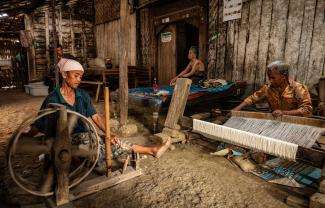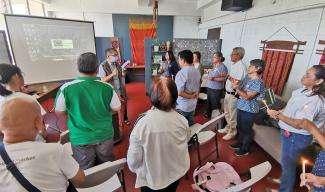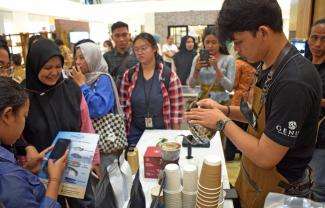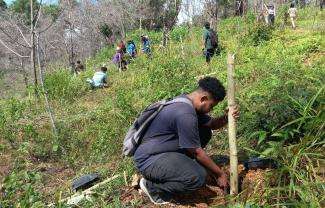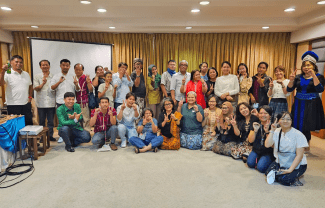From Sabang to Merauke and from sarung to kebaya, textiles are central to many Indonesian traditions and woven into the national culture. Now, a homegrown organisation in Java is working to make these fabrics more sustainable. With grant funding from Samdhana Institute , Sekar Kawung is producing eco-friendly, artisan cotton that can reduce Indonesia’s carbon footprint, while also creating jobs for local people. As the fashion industry comes to terms with its role in the global carbon crisis, Sekar Kawung offers a greener, more sustainable trend to follow.
Dressed to Kill: the Problem with Fashion
Greenhouse gas (GHG) emissions continue to turn up the heat on climate change. Surprisingly, one of the biggest culprits is the fashion industry, which produces about 10% of global carbon emissions each year – more than all shipping and international flights combined. And the problem continues to get worse. On average, people are buying 60% more clothes now than they did at the turn of the century, and wearing them for half as long. Clearly, with its wasteful production and unsustainable practices, the industry is in need of a new look.
“Every year, the fashion industry emits more carbon than all shipping and international flights combined.”
And this is especially true in Indonesia, where 99.9% of cotton is imported. These raw materials are shipped from countries in Latin America, along with the United States, China and Vietnam, and all that travel adds extra weight to Indonesia’s carbon footprint. Localising cotton production and fabric manufacture to Indonesia would certainly have a positive impact on carbon emissions. But this development also offers a range of other, more localised benefits too; evolving towards locally produced, sustainable textiles would create more jobs for local communities and empower makers of traditional fabrics throughout the archipelago.
The Fashion Industry’s Environmental Impact
10% of global carbon emissions come from the fashion industry
Fashion-related GHG emissions are expected to increase 50% by 2030
99.9% of cotton worn in Indonesia comes from abroad
Textile production in Indonesia makes up >6% of the manufacturing sector
An estimated 100 billion new garments are made every year
Local Traditions Offer Solutions to a Modern, Global Issue
Back in 2015, Sekar Kawung began working with traditional artisans in East Sumba, helping them gain access to natural dyes that are locally produced and more environmentally friendly than many of the imported alternatives. Then, in 2019, the group teamed up with women farmers and textile artisans in the Kerek sub-district of Tuban Regency, East Java. Here, among their crops of maize and mung bean, women grow cotton and spin it into yarn, which can be woven into cloth. This fabric is then brought to life using a mix of natural dyes and traditional decorative techniques. The women here craft a wide variety of different outfits in many different styles, including batik. With a little extra help, they are now beginning to standardise the process, improving quality control and branching out into modern designs that remain firmly rooted in local tradition.
From Farm to Wardrobe: Growing a Sustainable Business Ecosystem
In 2021, following two years of promising development, Sekar Kawung was looking to expand its business and extend its reach. It received CSR funding support from Maybank, which was channelled into new technologies that could support the cotton production process.
Then, in 2022, with a grant of IDR 145 million (almost US$10,000) from Samdhana, this production went up another gear; they began producing their own pisano cloth, which incorporates the latest innovations in thread technology; and a new range of woven fabrics, which take their inspiration from traditional gedog weaving, but offer greater speed and strength than manual spinning techniques.
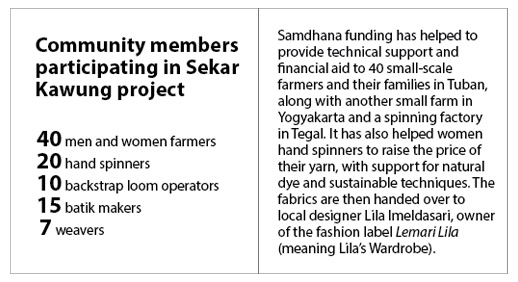
By making minor adjustments and improvements to every step of the process, the end product has been improved, making it more viable for sale and a more reliable source of income for those involved in its creation. The end result is a collaborative, sustainable and fair system, with value added throughout the supply chain.
“A collaborative, sustainable and fair system, with value added throughout the supply chain.”
Taking Centre Stage at Yogyakarta Fashion Week
From the start, Sekar Kawung’s goal has been to build a sustainable, circular production line. Samdhana funding has helped this process evolve into a more professional operation. But in order for the raw materials and processing phase to be sustainable, they require an end product that is saleable.
By teaming up with local designer Lila Imeldasari, Sekar Kawung and Samdhana found the final piece of the puzzle. Imeldasari was able to craft these organic and eco-friendly fabrics into designs that combined all the elegance of traditional dress with a new and dynamic modern flair.
On 22 August last year, these designs were showcased at Yogyakarta Fashion Week 2022. The theme of the event was ‘Karya Wastra Bhineka’, in tribute to the beauty and ethnic diversity of Indonesia. Proudly representing their corner of the archipelago, Sekar Kawung and Lila Imeldasari presented the Muluh Collection; a range of designs inspired by Javanese attire and crafted from homegrown fabrics.
“Focusing on local, homespun production dramatically reduces the environmental impact of clothing production.”
Many of these creations subsequently went on sale at Imeldasari’s boutique in Yogyakarta, which carries the same name as her brand – Lemari Lila. Here, fashionistas can buy local designs made from hand-crafted fabrics, cultivated in fields not far from the dressing room door. This focus on local, homespun production dramatically reduces the environmental impact of clothing production, while also providing a sustainable source of income for local communities that’s rooted in local heritage.
The Sekar Kawung model is designed to be scalable. With the right investment, it has the potential to reduce Indonesia’s dependence on imported fabrics and significantly lower carbon emissions associated with the production of textiles. Working together with Samdhana, the group intends to trial, refine and improve this model over the next 18 months, before replicating their success in other traditional textile-producing communities around Indonesia.
Today, Sekar Kawung fabrics are turning heads on the catwalks of Yogyakarta. Pretty soon, they could prove to be a game changer on the world stage.
(Written by Chris Alexander for the Samdhana Institute)
